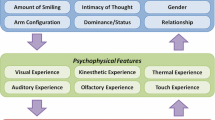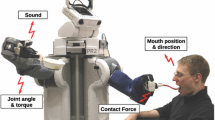Abstract
In this work, we discuss a set of feature representations for analyzing human spatial behavior (proxemics) motivated by metrics used in the social sciences. Specifically, we consider individual, physical, and psychophysical factors that contribute to social spacing. We demonstrate the feasibility of autonomous real-time annotation of these proxemic features during a social interaction between two people and a humanoid robot in the presence of a visual obstruction (a physical barrier). We then use two different feature representations—physical and psychophysical—to train Hidden Markov Models (HMMs) to recognize spatiotemporal behaviors that signify transitions into (initiation) and out of (termination) a social interaction. We demonstrate that the HMMs trained on psychophysical features, which encode the sensory experience of each interacting agent, outperform those trained on physical features, which only encode spatial relationships. These results suggest a more powerful representation of proxemic behavior with particular implications in autonomous socially interactive and socially assistive robotics.















Similar content being viewed by others
Notes
These proxemic distances pertain to Western American culture—they are not cross-cultural.
In this implementation, head pose was used to estimate the visual code; however, as the size of each person’s face in the recorded image frames was rather small, the results from the head tracker were quite noisy [37]. If the head pose estimation confidence was below some threshold, the system would instead rely on the shoulder pose for eye gaze estimates.
In this implementation, we utilized the 3-dimensional point cloud provided by our motion capture system for improved accuracy (see Sect. 4.1); however, we assume nothing about the implementations of others, so total distance can be used for approximations in the general case.
More formally, Hall’s touch code distinguishes between caressing and holding, feeling or caressing, extended or prolonged holding, holding, spot touching (hand peck), and accidental touching (brushing); however, automatic extraction of such forms of touching go beyond the scope of this work.
For example, we do not measure the radiant heat or odor transmitted by one individual and the intensity at the corresponding sensory organ of the receiving individual.
This occurs for the SFP axis estimates, as well as at the public distance interval, the loud and very loud voice loudness intervals, and the outside reach kinesthetic interval.
References
Adams L, Zuckerman D (1991) The effect of lighting conditions on personal space requirements. J Gen Psychol 118(4):335–340
Aiello J (1987) Human spatial behavior. In: Handbook of environmental psychology, Chap 12. Wiley, New York
Aiello J, Aiello T (1974) The development of personal space: proxemic behavior of children 6 through 16. Human Ecol. 2(3):177–189
Aiello J, Thompson D, Brodzinsky D (1981) How funny is crowding anyway? Effects of group size, room size, and the introduction of humor. Basic Appl Soc Psychol 4(2):192–207
Argyle M, Dean J (1965) Eye-contact, distance, and affliciation. Sociometry 28:289–304
Bailenson J, Blascovich J, Beall A, Loomis J (2001) Equilibrium theory revisited: mutual gaze and personal space in virtual environments. Presence 10(6):583–598
Burgoon J, Stern L, Dillman L (1995) Interpersonal adaptation: dyadic interaction patterns. Cambridge University Press, New York
Cassell J, Sullivan J, Prevost S (2000) Embodied conversational agents. MIT Press, Cambridge
Dempster A, Laird N, Rubin D (1977) Maximum likelihood from incomplete data via the EM algorithm. J R Stat Soc 39:1–38
Deutsch RD (1977) Spatial structurings in everyday face-to-face behavior: a neurocybernetic model. The Association for the Study of Man-Environment Relations, Orangeburg
Evans G, Wener R (2007) Crowding and personal space invasion on the train: please don’t make me sit in the middle. J Environ Psychol 27:90–94
Feil-Seifer D, Matarić M (2011) Automated detection and classification of positive vs negative robot interactions with children with autism using distance-based features. In: HRI, Lausanne, pp 323–330
Geden E, Begeman A (1981) Personal space preferences of hospitalized adults. Res Nurs Health 4:237–241
Hall ET (1959) The silent language. Doubleday Co, New York
Hall E (1963) A system for notation of proxemic behavior. Am Anthropol 65:1003–1026
Hall ET (1966) The hidden dimension. Doubleday Co, Chicago
Hall ET (1974) Handbook for proxemic research. American Anthropology Assn, Washington
Hayduk L, Mainprize S (1980) Personal space of the blind. Soc Psychol Q 43(2):216–223
Hediger H (1955) Studies of the psychology and behaviour of captive animals in zoos and circuses. Butterworths Scientific Publications, Stoneham
Huettenrauch H, Eklundh K, Green A, Topp E (2006) Investigating spatial relationships in human-robot interaction. In: IROS, Beijing
Jan D, Traum DR (2007) Dynamic movement and positioning of embodied agents in multiparty conversations. In: Proceedings of the 6th international joint conference on autonomous agents and multiagent systems, AAMAS ’07, pp 14:1–14:3
Jan D, Herrera D, Martinovski B, Novick D, Traum D (2007) A computational model of culture-specific conversational behavior. In: Proceedings of the 7th international conference on intelligent virtual agents, IVA ’07, pp 45–56
Jones S, Aiello J (1973) Proxemic behavior of black and white first-, third-, and fifth-grade children. J Pers Soc Psychol 25(1):21–27
Jones S, Aiello J (1979) A test of the validity of projective and quasi-projective measures of interpersonal distance. West J Speech Commun 43:143–152
Jung J, Kanda T, Kim MS (2013) Guidelines for contextual motion design of a humanoid robot
Kendon A (1990) Conducting interaction—patterns of behavior in focused encounters. Cambridge University Press, New York
Kennedy D, Gläscher J, Tyszka J, Adolphs R (2009) Personal space regulation by the human amygdala. Nat Neurosci 12:1226–1227
Kristoffersson A, Severinson Eklundh K, Loutfi A (2013) Measuring the quality of interaction in mobile robotic telepresence: a pilot’s perspective. Int J Soc Robot 5(1):89–101
Kuzuoka H, Suzuki Y, Yamashita J, Yamazaki K (2010) Reconfiguring spatial formation arrangement by robot body orientation. In: HRI, Osaka
Lawson B (2001) Sociofugal and sociopetal space, the language of space. Architectural Press, Oxford
Llobera J, Spanlang B, Ruffini G, Slater M (2010) Proxemics with multiple dynamic characters in an immersive virtual environment. ACM Trans Appl Percept 8(1):3:1–3:12
Low S, Lawrence-Zúñiga D (2003) The anthropology of space and place: locating culture. Blackwell Publishing, Oxford
Mead R, Matarić M (2011) An experimental design for studying proxemic behavior in human-robot interaction. Tech Rep CRES-11-001, USC Interaction Lab, Los Angeles
Mead R, Matarić MJ (2012) Space, speech, and gesture in human-robot interaction. In: Proceedings of the 14th ACM international conference on multimodal interaction, ICMI ’12, Santa Monica, CA, pp 333–336
Mead R, Atrash A, Matarić MJ (2011) Recognition of spatial dynamics for predicting social interaction. In: HRI, Lausanne, Switzerland, pp 201–202
Mehrabian A (1972) Nonverbal communication. Aldine Transcation, Piscataway
Morency L, Whitehill J, Movellan J (2008) Generalized adaptive view-based appearance model: integrated framework for monocular head pose estimation. In: 8th IEEE international conference on automatic face gesture recognition (FG 2008), pp 1–8
Mumm J, Mutlu B (2011) Human-robot proxemics: physical and psychological distancing in human-robot interaction. In: HRI, Lausanne, pp 331–338
Oosterhout T, Visser A (2008) A visual method for robot proxemics measurements. In: HRI workshop on metrics for human-robot interaction, Amsterdam
Pelachaud C, Poggi I (2002) Multimodal embodied agents. Knowl Eng Rev 17(2):181–196
Price G, Dabbs J Jr. (1974) Sex, setting, and personal space: changes as children grow older. Pers Soc Psychol Bull 1:362–363
Rabiner LR (1990) A tutorial on hidden Markov models and selected applications in speech recognition. In: Readings in speech recognition, pp 267–296
Satake S, Kanda T, Glas DF, Imai M, Ishiguro H, Hagita N (2009) How to approach humans?: Strategies for social robots to initiate interaction. In: HRI, pp 109–116
Schegloff E (1998) Body torque. Soc Res 65(3):535–596
Schöne H (1984) Spatial orientation: the spatial control of behavior in animals and man. Princeton University Press, Princeton
Shotton J, Fitzgibbon A, Cook M, Sharp T, Finocchio M, Moore R, Kipman A, Blake A (2011) Real-time human pose recognition in parts from single depth images. In: CVPR
Sommer R (1967) Sociofugal space. Am J Sociol 72(6):654–660
Takayama L, Pantofaru C (2009) Influences on proxemic behaviors in human-robot interaction. In: IROS, St. Louis
Torta E, Cuijpers RH, Juola JF, van der Pol D (2011) Design of robust robotic proxemic behaviour. In: Proceedings of the third international conference on social robotics, ICSR’11, pp 21–30
Trautman P, Krause A (2010) Unfreezing the robot: navigation in dense, interacting crowds. In: IROS, Taipei
Vasquez D, Stein P, Rios-Martinez J, Escobedo A, Spalanzani A, Laugier C (2012) Human aware navigation for assistive robotics. In: Proceedings of the thirteenth international symposium on experimental robotics, ISER’12, Québec City, Canada
Walters M, Dautenhahn K, Boekhorst R, Koay K, Syrdal D, Nehaniv C (2009) An empirical framework for human-robot proxemics. In: New frontiers in human-robot interaction, Edinburgh
Acknowledgements
This work is supported in part by an NSF Graduate Research Fellowship, as well as ONR MURI N00014-09-1-1031 and NSF IIS-1208500, CNS-0709296, IIS-1117279, and IIS-0803565 grants. We thank Louis-Philippe Morency for his insights in integrating his head pose estimation system [37] and in the experimental design process, and Mark Bolas and Evan Suma for their assistance in using the PrimeSensor, and Edward Kaszubski for his help in integrating the proxemic feature extraction and behavior recognition systems into the Social Behavior Library.
Author information
Authors and Affiliations
Corresponding author
Rights and permissions
About this article
Cite this article
Mead, R., Atrash, A. & Matarić, M.J. Automated Proxemic Feature Extraction and Behavior Recognition: Applications in Human-Robot Interaction. Int J of Soc Robotics 5, 367–378 (2013). https://doi.org/10.1007/s12369-013-0189-8
Accepted:
Published:
Issue Date:
DOI: https://doi.org/10.1007/s12369-013-0189-8




